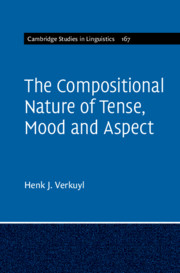Book contents
- Frontmatter
- Dedication
- Contents
- List of Figures
- List of Tables
- Preface
- 1 Introductory Chapter
- 2 How to Deal with the Long Tradition of Going Ternary?
- 3 Binary Tense Structure
- 4 Naive Physics and Aspectual Composition
- 5 Levels of Interaction between Aspect and Tense
- 6 Binary Tense Structure and Adverbial Modification
- 7 How to Deal Binarily with ...?
- 8 Tense, Mood and Aspect
- Appendix
- Bibliography
- Author Index
- Subject Index
5 - Levels of Interaction between Aspect and Tense
Published online by Cambridge University Press: 08 October 2021
- Frontmatter
- Dedication
- Contents
- List of Figures
- List of Tables
- Preface
- 1 Introductory Chapter
- 2 How to Deal with the Long Tradition of Going Ternary?
- 3 Binary Tense Structure
- 4 Naive Physics and Aspectual Composition
- 5 Levels of Interaction between Aspect and Tense
- 6 Binary Tense Structure and Adverbial Modification
- 7 How to Deal Binarily with ...?
- 8 Tense, Mood and Aspect
- Appendix
- Bibliography
- Author Index
- Subject Index
Summary
Chapter 5 describes how all verbs are anchored in the system of positive real numbers R+ by focussing on the meaning of a verb without taking into account its arguments. This makes it possible to distinguish stative from non-stative verbs by assigning to each of them a (mathematical) function determining the value of the eventuality argument ?? of the verb. The next step is then to separate non-stative verbs expressing continuity in R+ from verbs expressing discreteness in N by assigning to the latter a discretizing function mapping from R+ to N. A formal account of aspectual composition from the tenseless bottom to the tensed top S’makes it possible to distinguish the (ten) factors that are in play on different levels of phrase structure.
Keywords
- Type
- Chapter
- Information
- The Compositional Nature of Tense, Mood and Aspect , pp. 131 - 168Publisher: Cambridge University PressPrint publication year: 2021

